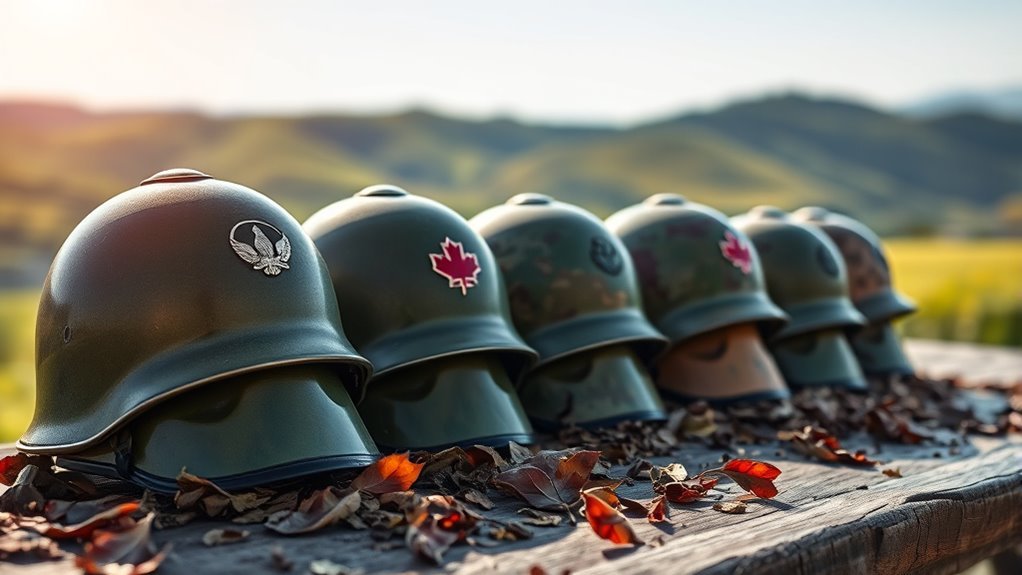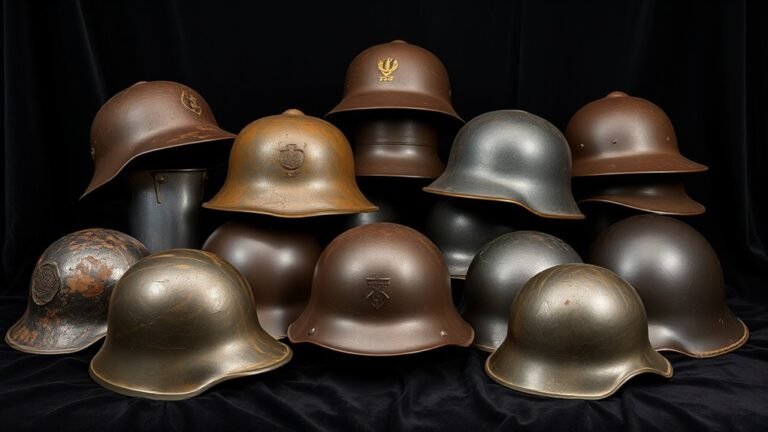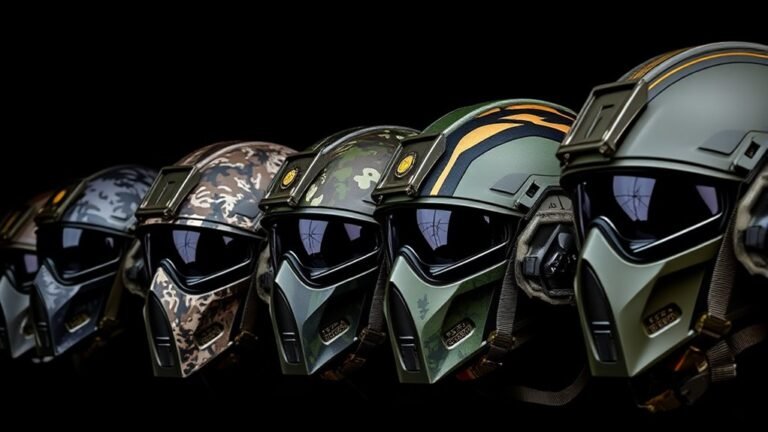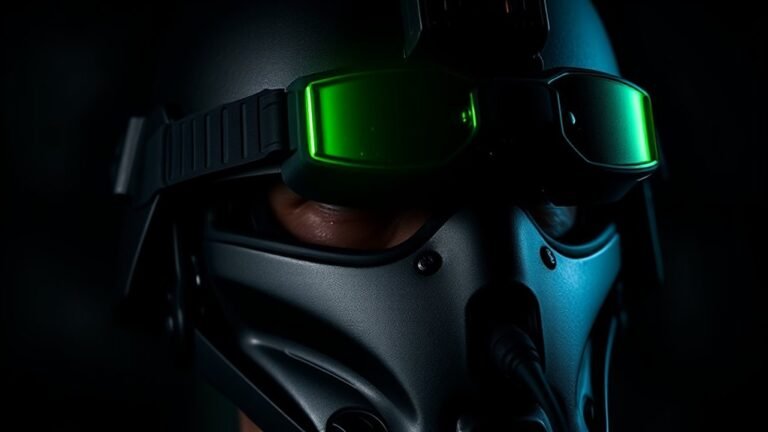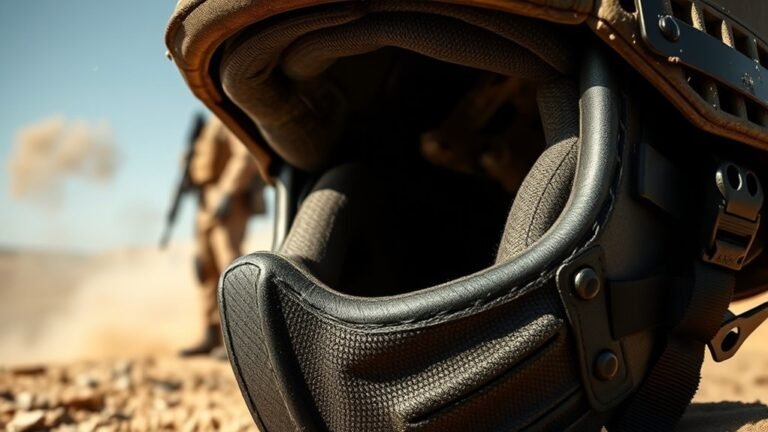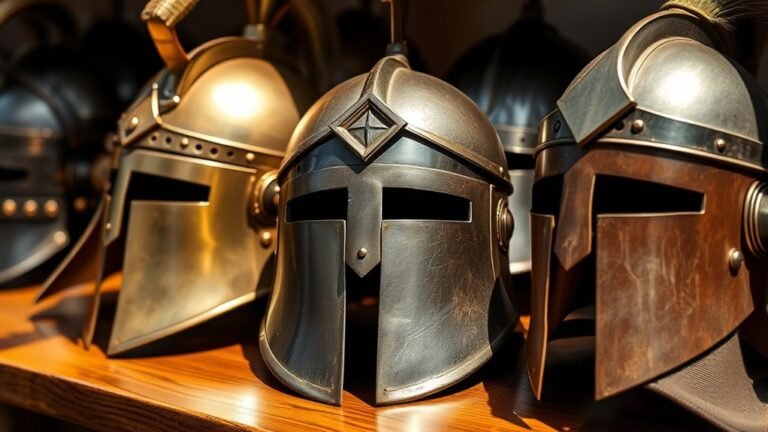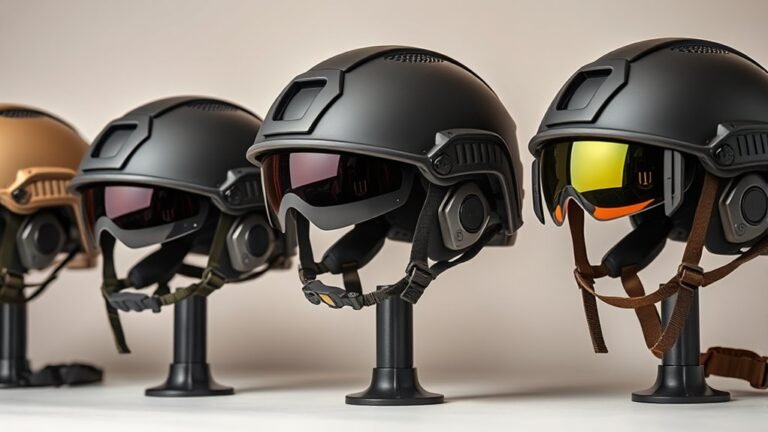Military Helmets Used in Peacekeeping Missions
Military helmets used in peacekeeping missions have advanced substantially. They’ve shifted from basic designs to incorporating lightweight composites and smart materials for enhanced protection and comfort. Modern helmets offer robust ballistic features while remaining light, with adjustable straps and moisture-wicking liners. Many also integrate communication systems for efficient coordination. Understanding these helmets’ features and designs is essential for effective operational strategy. Explore further to uncover more about the innovations and adaptations that shape their functionality.
Evolution of Military Helmet Design
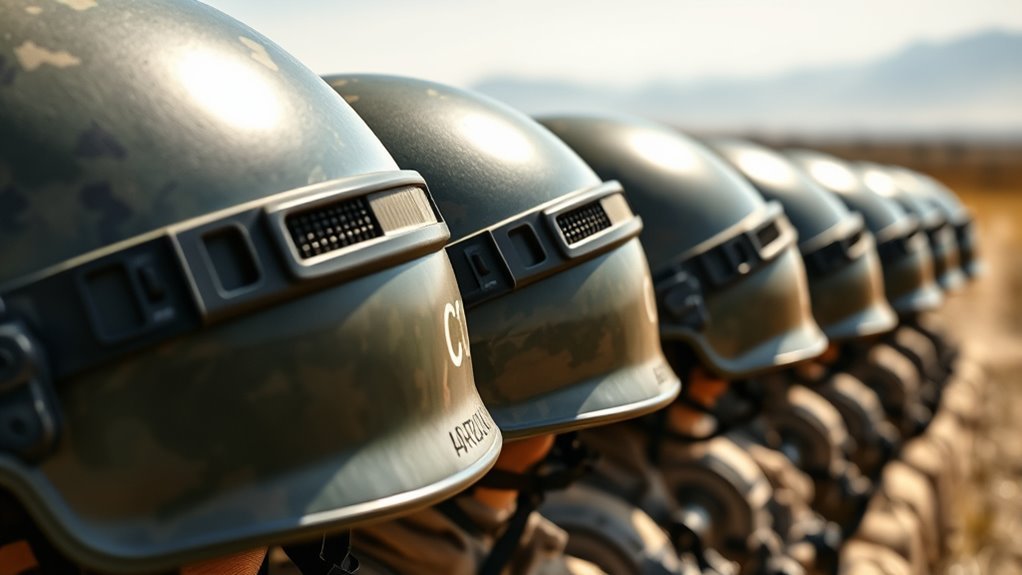
Over the past century, military helmet design has undergone significant transformations, reflecting advancements in materials and an evolving understanding of combat needs. Historical comparisons reveal how early designs prioritized basic protection, often sacrificing comfort and functionality. As you consider design influences, you’ll notice that innovations like lightweight synthetic materials and modular components have redefined modern helmets, enhancing both safety and versatility. The shift from rigid metal to composite structures illustrates a commitment to improved ballistic performance while maintaining mobility. Additionally, advancements in ergonomics have led to more user-friendly designs, ensuring soldiers can operate effectively in diverse environments. These changes underscore a broader trend: the necessity for helmets to adapt continually to the dynamic nature of conflict, emphasizing freedom and resilience for the wearer.
Key Features of Modern Peacekeeping Helmets
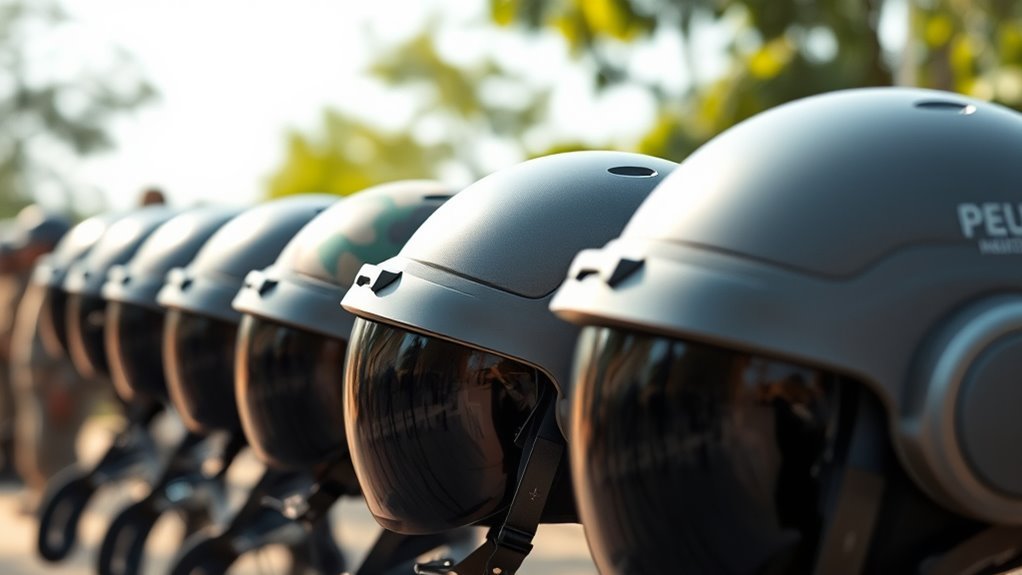
Modern peacekeeping helmets are engineered with a range of essential features designed to enhance soldier safety and operational effectiveness. One key aspect is their robust ballistic protection, which shields against various threats while maintaining a lightweight profile. You’ll also find advanced design aesthetics that blend functionality with a low visual footprint, vital for missions requiring discretion. Comfort features are equally important; adjustable straps and moisture-wicking liners guarantee a secure fit and reduce fatigue during extended wear. Furthermore, many helmets incorporate communication systems seamlessly, enabling clear coordination among troops. Enhanced ventilation systems further promote comfort in diverse environments, allowing for extended operational capability. Collectively, these attributes reflect a commitment to optimizing both protection and usability in modern peacekeeping operations.
Types of Helmets Used in Peacekeeping Operations
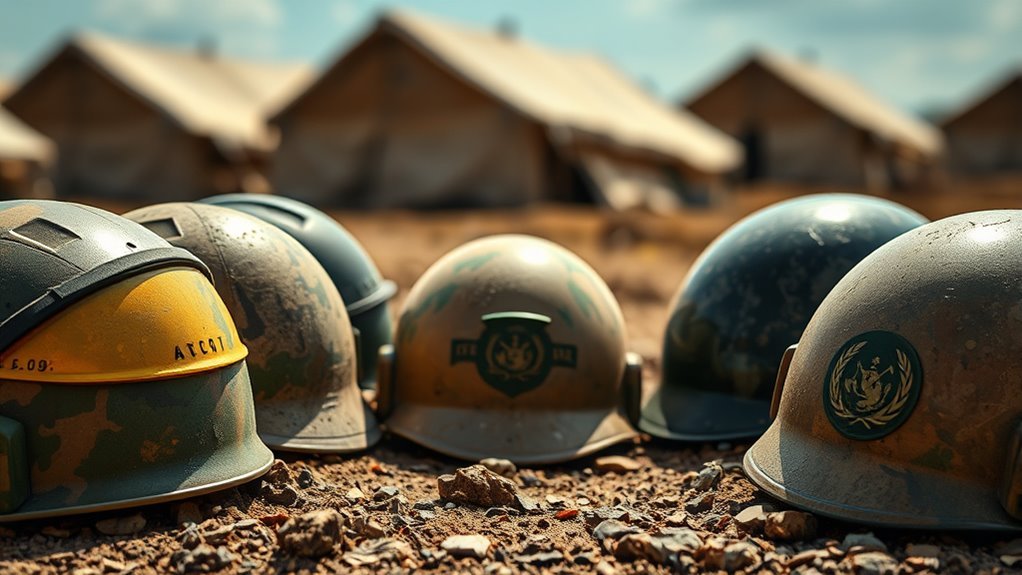
Various types of helmets are employed in peacekeeping operations, each tailored to meet specific mission requirements and threats. You’ll find that helmets are designed for diverse combat scenarios, incorporating advanced helmet materials such as Kevlar and polycarbonate. These materials offer a balance between protection and weight, guaranteeing that troops can maneuver effectively while remaining safeguarded against potential threats. Some helmets feature integrated communication systems, allowing for seamless coordination among peacekeeping forces. Others may include visors or face shields for enhanced protection in volatile environments. By understanding the different types of helmets and their specific applications, you can better appreciate the tactical decisions made to guarantee the safety and effectiveness of peacekeeping personnel in the field.
Innovations in Helmet Technology
Advancements in helmet technology have greatly enhanced the capabilities and safety of peacekeeping forces. These innovations focus on integrating smart materials and modular designs, allowing for improved functionality and adaptability in various environments.
Recent advancements in helmet technology significantly boost the safety and effectiveness of peacekeeping forces through innovative materials and designs.
- Smart materials that can change properties based on external conditions, enhancing protection.
- Modular designs enabling easy attachment of communication devices or additional armor.
- Lightweight composites reducing fatigue during prolonged missions without sacrificing safety.
- Integrated sensors providing real-time data on environmental threats and soldier health.
These enhancements not only improve operational effectiveness but also foster a sense of freedom for peacekeepers, allowing them to focus on their mission rather than the limitations of outdated equipment.
The Role of Helmets in Soldier Safety
In evaluating soldier safety, helmets serve critical functions, particularly through impact protection features designed to absorb and dissipate energy from potential threats. Additionally, enhanced visibility design elements guarantee that soldiers remain identifiable in various environments, reducing the risk of friendly fire. Understanding these aspects is essential for optimizing helmet performance in peacekeeping missions.
Impact Protection Features
Helmets play an essential role in safeguarding soldiers during peacekeeping missions, with their design focusing heavily on impact protection features. These helmets are engineered to guarantee maximum safety through advanced material technologies and structural integrity.
- Impact resistance to minimize injuries from blunt force trauma
- Shock absorption systems that dissipate energy upon impact
- Lightweight materials for enhanced mobility without compromising safety
- Ergonomic designs for better fit and comfort during prolonged use
Enhanced Visibility Design
While the primary function of military helmets is to provide protection, their design increasingly incorporates enhanced visibility features that are essential for soldier safety in peacekeeping missions. By utilizing color contrast, these helmets allow soldiers to stand out against varied environments, reducing the risk of friendly fire. Reflective materials are another key component, ensuring visibility in low-light conditions or during nighttime operations. These elements not only promote individual safety but also enhance overall mission effectiveness by facilitating easier identification among troops and civilians. As peacekeeping missions often occur in complex, unpredictable settings, the integration of enhanced visibility features into helmet design is a crucial advancement, ensuring soldiers can operate confidently while maintaining a clear presence in the field.
Helmet Adaptations for Various Environments
As peacekeeping missions often occur in diverse and challenging environments, the adaptation of military helmets becomes essential for ensuring personnel safety and operational effectiveness. Utilizing effective adaptation techniques tailored to specific environmental considerations can greatly enhance performance. Here are some adaptations you might encounter:
- Modular designs for quick attachment of communication devices
- Heat-resistant materials for operation in high-temperature regions
- Waterproof coatings to protect against harsh weather
- Integrated ballistic visors for added facial protection
These adaptations not only improve functionality but also allow personnel to remain agile and responsive in varied conditions. By focusing on these key features, helmets can provide essential protection while accommodating the unique demands of peacekeeping missions.
Future Trends in Military Helmet Development
The evolution of military helmets is increasingly influenced by advancements in technology and a deeper understanding of operational requirements. Future trends will likely integrate smart textiles and modular designs, enhancing functionality while maintaining comfort and protection. You can expect helmets that adapt to environmental conditions and user needs, allowing for real-time communication and monitoring.
| Feature | Current Technology | Future Trends |
|---|---|---|
| Material | Kevlar | Smart textiles |
| Design | Fixed structure | Modular designs |
| Functionality | Basic protection | Integrated systems |
As a result, helmets will not only shield you from physical threats but also empower you with data and adaptability, ensuring your operational effectiveness and safety in peacekeeping missions.
Frequently Asked Questions
How Are Military Helmets Tested for Safety and Durability?
Military helmets are tested for safety and durability through rigorous impact assessments that conform to established testing standards. These evaluations simulate various conditions, such as projectile impacts and blunt force trauma, ensuring the helmets can withstand real-world scenarios. You’ll find that materials are scrutinized for both strength and weight, providing ideal protection without sacrificing mobility. Ultimately, this meticulous testing process guarantees that the helmets you wear safeguard your freedom while maintaining reliability in the field.
What Materials Are Commonly Used in Peacekeeping Helmets?
Peacekeeping helmets commonly use composite materials like Kevlar, fiberglass, and carbon fiber due to their high strength-to-weight ratios. These materials enhance helmet design by providing effective ballistic protection while ensuring comfort and mobility for the wearer. The integration of advanced composites not only improves durability but also contributes to the overall safety of personnel in various environments, enabling them to perform their duties with greater confidence and security in the field.
How Do Soldiers Maintain Their Helmets in the Field?
To maintain your helmet in the field, you’ll need to focus on regular helmet cleaning and proper helmet storage. Cleaning involves using mild soap and water to remove dirt or debris, guaranteeing visibility and functionality. After use, store the helmet in a cool, dry place, avoiding direct sunlight or extreme temperatures that could degrade materials. Regular checks for cracks or wear are essential to make sure your helmet remains effective when you need it most.
Are There Any Specific Regulations for Helmet Use in Peacekeeping?
Yes, there are specific regulations governing helmet use in peacekeeping. You’ll find that helmet standards are outlined in various peacekeeping protocols, emphasizing protection while ensuring operational efficiency. These protocols dictate the type of helmets used, their weight, and additional features like ballistic protection. Adhering to these standards not only enhances soldier safety but also fosters trust within the communities they serve, reflecting a commitment to both security and the ideals of peace.
How Do Helmets Affect Communication Among Peacekeeping Troops?
Helmets can greatly enhance communication among peacekeeping troops. With advanced helmet design integrating communication technology, you’ll find troops can relay essential information quickly and clearly, even in chaotic environments. Some might argue that helmets hinder hearing, but modern designs minimize this issue, allowing for both protection and effective communication. By facilitating real-time exchanges, these helmets guarantee that you and your team can respond swiftly, maintaining situational awareness and operational efficiency in the field.
